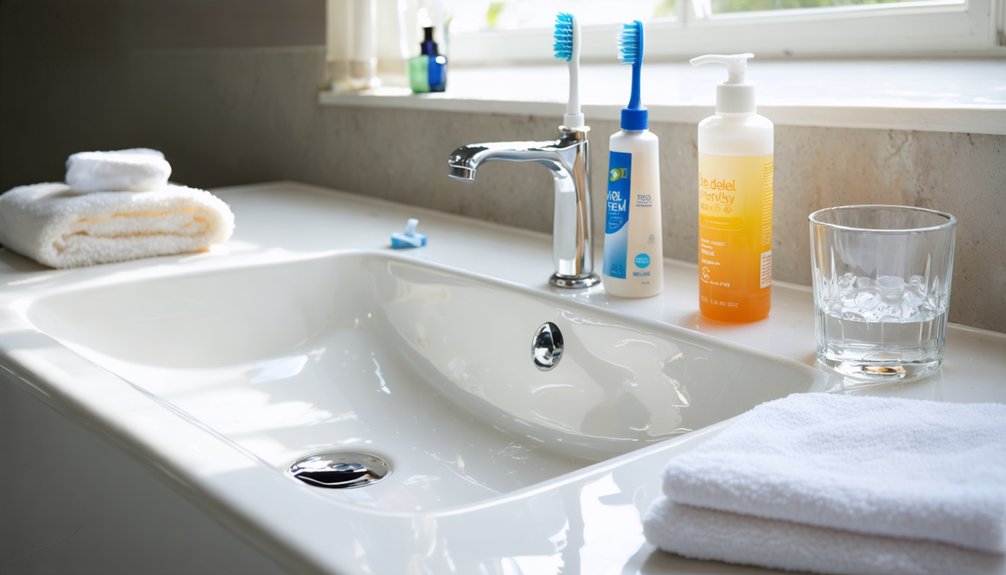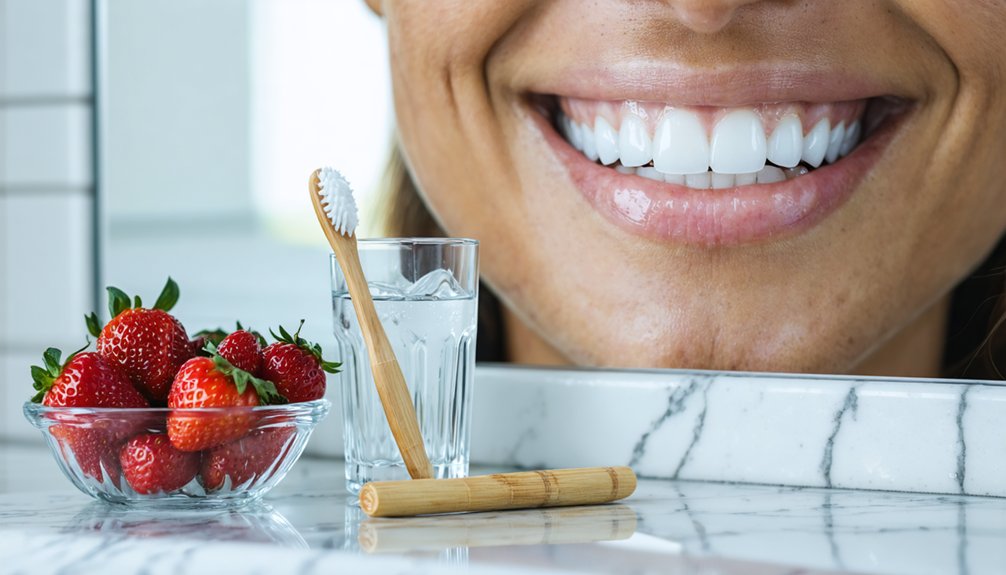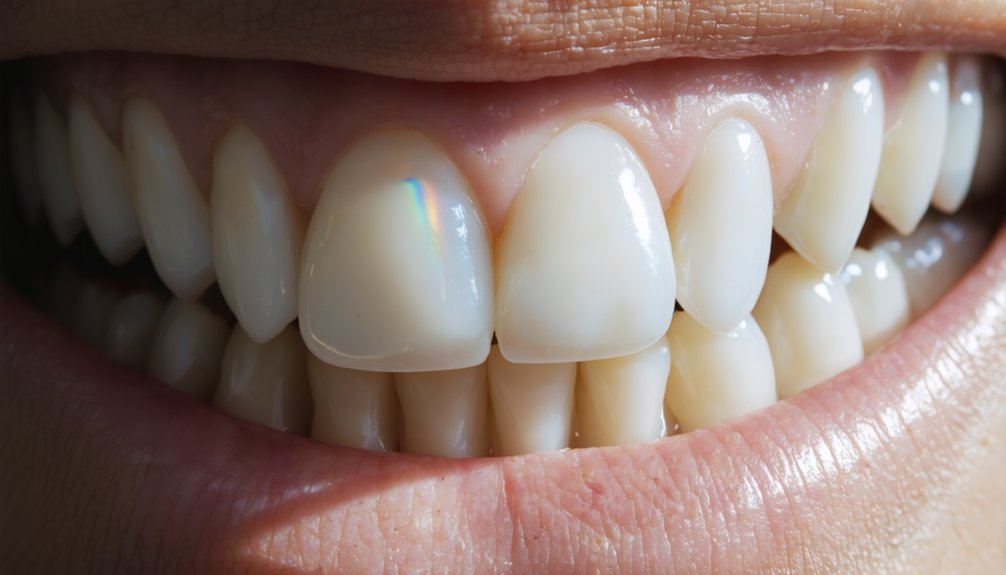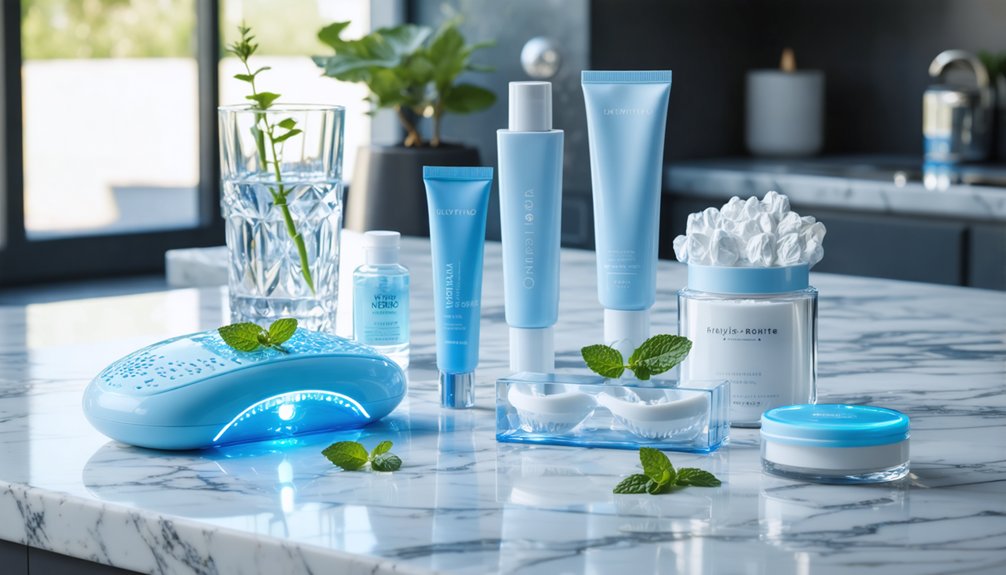You can safely brighten sensitive teeth by using low-concentration whitening products specifically designed for sensitivity, scheduling professional treatments with custom-fitted trays, and implementing gentle at-home care methods. Start with desensitizing toothpaste two weeks before whitening, avoid acidic foods, and use soft-bristled brushes. Maintain proper dental hygiene, stay hydrated, and consider natural alternatives like oil pulling. Understanding the complete approach to enamel care will help you achieve ideal whitening results.
Key Takeaways
- Use low-concentration whitening products containing 3-10% hydrogen peroxide or 10-16% carbamide peroxide to minimize sensitivity while effectively removing stains.
- Brush with desensitizing toothpaste containing potassium nitrate for 1-2 weeks before starting any whitening treatment.
- Choose professional custom-fitted trays for precise gel application and reduced gum irritation during whitening treatments.
- Implement staggered whitening sessions with recovery days between applications to protect sensitive enamel from excessive exposure.
- Mix baking soda with water for occasional gentle whitening, and use soft-bristled toothbrushes to prevent further enamel damage.
Understanding Your Enamel Sensitivity
When your teeth suddenly react to hot coffee or ice cream with sharp pain, you’re likely experiencing tooth sensitivity – a common condition affecting millions of people worldwide. This discomfort occurs when your protective enamel composition becomes compromised, exposing the underlying dentin layer with its microscopic nerve-connected tubules.
Understanding sensitivity triggers is essential for managing your condition. These can include temperature extremes, acidic foods, sweet substances, and pressure from biting. People aged 20 to 50 are most likely to experience tooth sensitivity. Using a soft-bristled toothbrush is crucial for preventing further enamel damage.
Knowing what sets off tooth sensitivity – from hot drinks to sugary snacks – helps you better control and prevent painful episodes.
Your enamel may be wearing down due to aggressive brushing, acid erosion, or mechanical damage. Alternatively, receding gums might be exposing your tooth roots, where the enamel is naturally thinner.
If you’re experiencing localized sensitivity in specific teeth, it could signal underlying issues like cavities or cracks that require professional attention.
Choosing the Right Whitening Products
When selecting whitening products for sensitive teeth, you’ll want to focus on formulas with lower peroxide concentrations that minimize enamel irritation while still providing effective results.
Natural alternatives like peroxide-free strips containing essential oils and plant-based ingredients offer gentle whitening options for those with heightened sensitivity.
LED light technology enhances the whitening process while being gentle on sensitive teeth.
Professional treatments from your dentist offer customized solutions with controlled application and proper protection, though they typically cost between $300-$1,000.
For a more affordable option, store-bought products like Crest 3D White Whitestrips Gentle Routine Kit or sensitivity-focused whitening toothpastes can provide gradual brightening while incorporating desensitizing ingredients like potassium nitrate and fluoride.
Low-Concentration Bleaching Options
Three key factors make low-concentration bleaching products ideal for sensitive teeth: reduced peroxide levels, specialized delivery systems, and protective additives. Temporary enamel demineralization may occur during treatment but typically resolves within days.
Low concentration options typically contain 3-10% hydrogen peroxide or 10-16% carbamide peroxide, offering gentle formulations that minimize enamel damage while effectively removing stains. Professional guidance from a dental care provider ensures safe and optimal results.
- Choose whitening strips or gels with built-in desensitizing ingredients like potassium nitrate or fluoride.
- Use custom-fitted trays to guarantee precise gel placement and reduced gum contact.
- Follow shortened application times of 30 minutes or less per session.
- Consider LED-assisted treatments that enhance results without requiring stronger peroxide.
These milder approaches allow for gradual whitening progress while maintaining enamel integrity through controlled oxidation and enhanced remineralization, making them particularly suitable for patients with heightened sensitivity.
Professional vs. Store Products
Although both professional and store-bought whitening products aim to brighten teeth, they differ considerably in their effectiveness, customization, and safety profiles.
Professional kits deliver superior results with up to 8-10 shades of improvement within days, while store products typically achieve minimal changes over several weeks. Highly concentrated bleaching formulas in professional kits ensure dramatic results compared to store options.
You’ll benefit from custom-fitted trays and personalized treatment protocols with professional solutions, ensuring even coverage and reduced sensitivity. Your dentist will monitor your progress and adjust concentrations based on your unique needs. Custom impressions allow for precise tray fitting that provides complete coverage of all tooth surfaces.
While store products cost less initially, they often require frequent repurchasing due to temporary results.
For sensitive enamel, professional supervision provides essential safety measures and immediate intervention if needed, making professional kits the more reliable choice for long-term whitening success.
Professional Treatment Options
For sensitive teeth, you’ll find that in-office laser whitening procedures offer carefully controlled bleaching with professional monitoring to minimize discomfort.
Dentin bonding agents can be applied before whitening treatments to protect exposed tooth surfaces and reduce sensitivity during the process.
Your dentist can provide custom-fitted trays with specialized whitening gels that contain desensitizing ingredients for at-home use.
These professional treatments deliver more predictable results than over-the-counter options while incorporating protective measures for your sensitive enamel. Treatment success increases when combined with regular use of desensitizing toothpaste as part of your daily oral care routine.
In-Office Laser Whitening Solutions
When it comes to brightening sensitive enamel, in-office laser whitening offers a professional solution that combines precision and efficiency.
The procedure uses high-concentration hydrogen peroxide gel with laser activation benefits to break down stains effectively. You’ll experience enhanced whitening results as the laser heats the gel, releasing oxygen radicals that penetrate your enamel. A typical whitening session duration ranges from 30 to 60 minutes.
- Your dentist will apply protective barriers to shield your gums from the bleaching agents.
- You can achieve 7-10 shades lighter teeth in a single treatment.
- Your enamel’s structural integrity remains protected through laser-assisted bleaching.
- You’ll receive customized sensitivity management protocols before and after treatment.
For ideal results and safety, professional evaluation guarantees the treatment aligns with your enamel’s sensitivity level.
Custom Tray Professional Treatments
Professional custom tray treatments offer a highly effective solution for whitening sensitive enamel while maximizing comfort and safety.
Created from precise dental impressions, these custom trays guarantee ideal gel distribution and minimize gum exposure, reducing sensitivity risks.
Your dentist will select professional whitening gels containing appropriate peroxide concentrations based on your enamel sensitivity. Many formulations include enamel-strengthening ingredients like fluoride and vitamins.
You’ll receive detailed guidance on treatment duration, typically ranging from 10 minutes to several hours daily over a one to two-week period.
Unlike over-the-counter options, custom trays provide superior fit and coverage while preventing gel leakage.
When combined with professional-grade whitening agents, you can achieve up to five shades of improvement while maintaining your enamel’s integrity.
Gentle At-Home Whitening Methods
People with sensitive teeth can still achieve a brighter smile through gentle at-home whitening methods that minimize discomfort. When establishing whitening routines, focus on products specifically formulated for sensitivity management, including low-peroxide strips, pens, and toothpastes containing potassium nitrate or fluoride.
Sensitive teeth don’t mean you can’t whiten safely. Choose gentle products with low peroxide levels and sensitivity-focused ingredients for optimal results.
- Use whitening products labeled “for sensitive teeth” and avoid highly abrasive agents that can damage delicate enamel.
- Implement staggered whitening sessions with recovery days between applications to prevent overwhelming sensitive areas.
- Maintain daily care with soft-bristled brushes and sensitivity toothpaste to strengthen enamel during treatment.
- Monitor your teeth’s response and adjust your whitening schedule if you experience increased discomfort.
Remember to supplement your whitening regimen with fluoride mouthwash and limit acidic foods to protect your enamel throughout the process.
Pre-Whitening Care and Preparation

Proper preparation before teeth whitening is essential for sensitive enamel and can greatly reduce discomfort during treatment. Start by scheduling a thorough dental exam to assess your enamel’s condition and identify areas requiring special attention.
Your dentist will evaluate thickness, recession, and previous sensitivity issues to create tailored pre treatment guidelines.
Begin using desensitizing toothpaste containing potassium nitrate 1-2 weeks before whitening, and receive professional fluoride treatments to strengthen your enamel.
You’ll need to avoid acidic foods, hot and cold beverages, and abrasive oral care products during this preparation phase.
Focus on gentle but thorough oral hygiene using non-abrasive fluoride toothpaste, and consider scheduling a professional cleaning.
This systematic approach to enamel care guarantees your teeth are ideally prepared for the whitening process.
Natural Alternatives for Teeth Brightening
Natural teeth brightening methods offer gentler solutions for those with sensitive enamel who want to avoid harsh chemical treatments.
For those with delicate teeth, nature’s gentle whitening methods provide a kinder path to a brighter, healthier smile.
When exploring natural remedies, you’ll find several options that can help improve your smile while protecting your teeth’s delicate surface.
- Mix baking soda with water to create a mild abrasive paste for occasional use, but avoid daily application to prevent enamel erosion.
- Practice oil pulling with coconut oil for 15-20 minutes daily as a safe, non-abrasive method to reduce bacteria and maintain oral health.
- Incorporate dietary choices like crunchy vegetables and non-acidic fruits into your meals to naturally scrub surface stains.
- Consider diluted hydrogen peroxide as a gentle bleaching option, but use sparingly and under professional guidance to prevent sensitivity.
Daily Habits for Maintaining White Teeth

Maintaining white teeth requires a strategic combination of daily habits that protect sensitive enamel while preserving brightness.
You’ll need to implement key lifestyle adjustments, starting with brushing twice daily at 12-hour intervals using fluoride toothpaste and gentle whitening formulas.
When making dietary modifications, opt for using straws with staining beverages and rinse your mouth with water after consuming acidic foods or drinks.
You should wait 30 minutes before brushing after acidic substances to prevent enamel erosion.
Daily flossing and proper hydration support your teeth’s natural cleansing mechanisms.
Replace your toothbrush every 3-4 months, and avoid frequent snacking on sugary foods.
For best results, incorporate antibacterial mouthwash into your routine and maintain regular dental checkups to monitor enamel health.
Managing Discomfort During Treatment
While managing sensitivity during teeth brightening treatments requires patience, several proven strategies can help minimize discomfort. Start by using desensitizing toothpaste consistently, twice daily, to block pain transmission through exposed dentin tubules. Professional fluoride treatments can strengthen your enamel and provide additional protection during the whitening process.
Sensitivity during teeth whitening can be effectively managed with desensitizing toothpaste and professional fluoride treatments to protect your enamel.
- Wait at least 30 minutes after consuming acidic foods before brushing to prevent further enamel wear.
- Use a soft-bristled toothbrush with gentle pressure to avoid aggravating sensitive areas.
- Rinse with water immediately after acidic beverages to neutralize pH levels.
- Consider scheduling professional fluoride applications every 3-6 months for ideal protection.
If sensitivity persists, consult your dentist about prescription-strength fluoride products or dental bonding options for enhanced comfort during treatment.
Long-Term Enamel Protection Strategies

To protect sensitive enamel for the long term, you’ll need an all-encompassing approach that combines proper nutrition, fluoride treatments, and protective dental procedures.
Start by incorporating calcium-rich foods and vitamin D sources to support enamel remineralization strategies. Regular fluoride application methods, including daily use of fluoridated toothpaste and professional varnish treatments, create a protective barrier against acid attacks.
Maintain ideal hydration to promote saliva production, which naturally repairs enamel through mineral replenishment.
Consider protective measures like sealants or veneers for vulnerable areas. You’ll also need to modify behaviors by using a soft-bristled toothbrush, limiting acidic beverages, and treating underlying conditions like GERD.
Regular dental check-ups guarantee timely intervention and monitoring of your enamel’s health status.
Safe Product Application Techniques
Successfully brightening sensitive enamel requires precise product application techniques that prioritize safety and comfort.
You’ll need to carefully control your application timing and guarantee proper enamel recovery between treatments to achieve ideal results while minimizing sensitivity risks.
- Use custom-fitted trays instead of generic options to guarantee even coverage and protect your gums from irritation.
- Apply whitening products for shorter intervals (2-4 hours per day) and space sessions appropriately to prevent enamel stress.
- Follow exact dosing instructions and avoid excess product application, which can increase sensitivity.
- Rinse thoroughly after each application to remove residual peroxide and protect nerve endings.
Remember to brush gently with soft-bristled brushes and non-abrasive toothpaste during your whitening treatment period to maintain enamel integrity.
Frequently Asked Questions
Can I Whiten My Teeth While Wearing Braces or Dental Crowns?
While braces safety limits whitening until removal to prevent uneven results, you can’t whiten dental crowns at all since they don’t respond to bleaching agents. Consider professional cleaning and whitening-safe toothpaste instead.
How Long Should I Wait Between Professional Cleanings and Starting Whitening Treatment?
Did you know 67% of patients experience less sensitivity when they wait? You’ll need 1-2 weeks between cleaning and whitening treatments for ideal enamel recovery, though sensitive teeth may require 2-4 weeks.
Will Whitening Treatments Affect Existing Dental Fillings or Bonding Materials?
Your whitening treatments won’t affect filling durability or lighten existing bonding materials. You’ll likely notice bonding discoloration compared to your natural teeth, so you may need restorations replaced to match.
Does Drinking Through a Straw Prevent Tooth Staining During Whitening?
While straws offer some stain prevention benefits, they won’t fully protect your teeth during whitening. You’ll still need proper enamel protection since your tongue spreads liquids across all tooth surfaces.
Can Certain Medications Interfere With Teeth Whitening Effectiveness?
Like storm clouds darkening a bright sky, many medication types – including antibiotics, antihistamines, and blood pressure drugs – can reduce whitening’s effectiveness. Consider professional whitening alternatives and consult your dentist for guidance.
References
- https://deefordentist.com/whitening-methods-for-sensitive-teeth/
- https://www.stadiumfamilydentistryannarbor.com/teeth-whitening-tips-and-tricks-for-sensitive-teeth/
- https://myvallejodentist.com/2024/06/27/how-to-reduce-tooth-sensitivity-during-whitening-treatment/
- https://pmc.ncbi.nlm.nih.gov/articles/PMC4058574/
- https://www.44thstdental.com/how-to-whiten-sensitive-teeth/
- https://keystonedentistry.com/blog/brightening-your-smile-dealing-with-sensitive-teeth-after-whitening/
- https://www.nextleveldentalstudio.com/post/6-natural-ways-to-safely-try-teeth-whitening-for-sensitive-teeth
- https://knoxvilledentalpartners.com/blog/teeth-whitening-for-sensitive-teeth-cip1800/
- https://www.greatlakesfamilydentalgroup.com/resources/articles/sensitive-teeth
- https://www.sensodyne.com/en-us/understanding-tooth-sensitivity/



